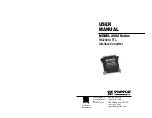
4 Product Overview
SMA Solar Technology AG
Operating manual
SBSxx-10-BE-en-11
24
Time-of-Use
With the "Time-of-Use" function, you can adjust the charging behavior of the battery to your
electricity tariff. Energy bills are thus reduced and electricity at lower cost can be used. You can
determine in which time range the battery with a specified charging power is operated. At specific
times, this is mostly useful when the battery's state of charge has to take on a certain value or the
tariff situation makes the charging more attractive, regardless of the power at the grid-connection
point. The charging parameters set in the power profile are only limited by the state of charge
(SOC). At times when the "Time-of-Use" function is not enabled, the battery is charged
correspondent to the increased self-consumption for the entire system. The "Time-of-Use" function is
disabled by default and must be enabled by creating power profiles.
Peak load shaving
With the "Peak Load Shaving" function, you can optimize the behavior of the battery inverter with
respect to the power exchange at the grid-connection point. This is mostly useful when a higher
supply of energy would lead to a higher electricity cost. With the "Peak Load Shaving" function,
certain grid-exchange power outputs to which the battery inverter is adjusted depending on its
power and battery capacity available can be set. Power peaks can thus be avoided.
You can configure times and setpoints for the power drawn at the grid-connection point. When the
loads require additional energy, the battery is discharged and the maximum value is kept constant
at the grid-connection point. This is based on the prerequisite that the battery is sufficiently charged.
At times when the "Peak Load Shaving" function is not activated, the battery is charged or
discharged correspondent to the increased self-consumption for the entire system. The "Peak Load
Shaving" function is deactivated by default and must be activated by creating power profiles.
Frequency Shift Power Control
If PV inverters are connected on the AC side during battery-backup operation, the battery inverter
must be able to limit their output power. This limitation becomes necessary when, for example, the
battery inverter's battery is fully charged and the power available from the PV system exceeds the
power requirement of the connected loads.
To prevent excess energy from overcharging the battery, the battery inverter automatically detects
the problem and changes the frequency at the AC output. This frequency adjustment is analyzed by
the PV inverter. As soon as the power frequency of the battery-backup grid increases beyond the
value specified in
f Start Delta
, the PV inverter limits its output power accordingly.
















































